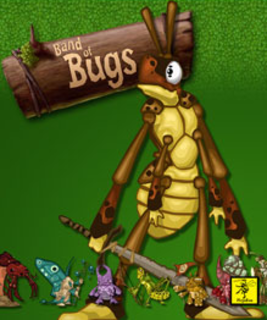Impressive online support and a level editor doesn’t manage to offset Band of Bugs’ simple core gameplay.
The single-player campaign follows the journey of Maal, the young military commander of his band of bugs. Twenty missions tell Maal’s story, but it isn’t interesting or compelling enough for you to form any kind of attachment to the characters. Mission objectives vary with each level and include defeating all enemy units, reaching an escape point, or surviving for a certain number of turns. The action takes place on a grid and feels quite similar to the Final Fantasy Tactics series. Units take turns to move around the map and perform attacks, special moves, and magic spells. Using the environment to your advantage, in conjunction with your unit’s abilities, is the key to success. Attacking from behind your opponent or from a higher position on the map will increase the damage you do. Certain grid tiles also have a significant bearing on combat; you’ll be dragged away by the sand flow if you stand on a quick-sand tile and you’ll take damage every turn if you stand on a poison tile.
Different bug types will join your band as you progress. The class types include archers, mages, and healers (there’s even a nod to the developers with the ninja bee class) which are all distinguished by their skills and abilities. Skills and spells are given a usage limit, rather than drawing on the familiar magic points (MP) system. Your bugs will automatically level up and get stronger as missions pass. This saves the player from the micro-management that can be so exhausting in traditional strategy games, but it also means there is no ability to customise how your units get stronger. Outside of the campaign, you can try your hand at the stand-alone missions or skirmish mode. The stand-alone missions place you in different scenarios with special victory conditions. These include reaching an escape point without losing any units and eliminating all enemy units before they reach an escape point. Victory conditions are often more challenging to meet than those of the campaign missions; the stand-alone missions are great if you are craving a greater challenge. Skirmish mode allows you to specify the game type and duration and jump straight into a battle against the AI. There isn’t much to skirmish mode that makes it particularly attractive. It might be of use to practise, but with the lack of unit customisation (and thus the inability to build strategies around certain units), it’s very limited.
Band of Bugs’ most interesting feature is the level editor. Players have the ability to create their own maps and take them online. Although there are some limits to the editor, the freedom it affords you is impressive. You have the ability to create every type of terrain tile at the height you want, set the starting positions of each unit, and decide on the game type. You can spend a lot of time crafting an intricate map, and this adds a lot of value to the game. The ability to take your own created maps online, and play on the maps of other gamers, adds more hours to the game.
Multi-player mode plays out exactly like skirmish except you can play locally or over Xbox Live. You can quickly join, search for, or create your own player or ranked match with up to seven other players (you can filter whether or not you want to join a game on a created map). Standard leaderboards are supported which allow you to track mission scores or your online record against your friends and the rest of the world. Band of Bug’s multi-player support is certainly one of its strongest points. The game runs steadily online, and the ability to play created maps with up to seven other players is a real bonus.
NinjaBee’s first two Arcade games had unique visual styles and Band of Bugs is no different. Colour is used to great effect, particularly in the environments. Throughout the game you’ll explore jungles, deserts, and mountain peaks to name a few. Character models are fairly impressive, too, with bug types as visually unique as they different in terms of combat ability. Archers take the form of quick quadrupeds and the frontline fighters are bulky bipeds. In terms of sound, there is less to get excited about. The same music rattles along in the background, and although it isn’t terrible, it will start to grate. Unfortunately, the potential to use voice acting to enhance the story was not realised. The story-progressing scenes at the beginning and end of each level have voice acting to an extent, but it’s in an incomprehensible bug language. Band of Bugs’ characters would have greatly benefited from high-quality English voice acting, giving the player the ability to connect with them more. The humorous script only reinforces this point.
Two-hundred GamerScore points are spread over twelve achievements of varying difficulties. You can acquire some easy points by using skills and spells a certain amount of times, winning a certain amount of online matches, and dispatching enemy units in creative ways (such as pushing them into a water tile). You will have to work for the full two-hundred points though, particularly for the achievement that requires you to gain gold medals on every campaign mission.
Band of Bugs is a good entry-level strategy game, but after a couple of hours play, you’ll find there isn’t much more to it. Experienced strategy gamers looking for a challenge should look elsewhere. If you can live with its simplicity, you’ll find Band of Bugs to be an enjoyable experience, particularly when playing online and creating maps, supported by a unique visual style that is rare in this genre.

